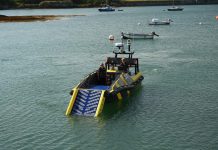Turbine owners, did you know that your end-of-warranty inspection may be the most important purchase you make since you bought the farm? The wind farm that is.
These words of wisdom come from one of my most respected coworkers, who shall remain nameless. His expertise and work emphasis is with end-of-warranty (EOW) inspections. So admittedly, he may be a bit biased. But I am not. I still think like a wind farmer and I listen to what he says.
I do know that the work that his specialized team performs has saved turbine owners millions of dollars in warranty claims. He has collected data for EOW on over 10,000 turbines and possesses an intimate knowledge of what is or may be happening inside your wind turbine. Armed with that knowledge, this team uses that data to save you money.
As turbines approach the EOW period, the stakes are high for OEMs and buyers alike. There are literally millions of dollars won or lost due to the quality of the EOW inspection that was performed. In the end, either the turbine manufacturer or the buyer reaps the benefits.
Of course, there is the possibility that your turbines do not have problems, but is that really the case? So why is there such a large spread in the quality and type of end-of-warranty services?
The problem lies in the large number of service providers in the industry that perform end-of-warranty inspections. These different contractors all have different pricing and skill levels. You may have to look beyond the cost of the inspection to get the most return on your warranty. But cost isn’t the real issue. The more pressing problem is that each company that provides end-of-warranty inspections perform their services in their own way and to a different level of expertise.
One of the main skills used in end of warranty inspections is in the use of a bore scope. This tool is a complicated device that allows you to place a camera in some not-so-accessible places. The borescope has a camera at the end of a flexible stick. The stick (or wand as it is known) can be many feet long and “snaked” into and between gearbox internal components.
Skilled operators can manipulate the tip of the bore scope wand into some very inaccessible places inside the gearbox or generator. This is one area in which experience really counts. For technicians, some of the limiting factors of their ability to collect the needed data may lie in the lack of guided training in operating this tool. They may have only performed a few supervised inspections before being cut loose on their own to make money for their service company. Some service providers require that their technicians perform 100 supervised inspections using this bore scope before they are allowed to perform one on their own.
Another difference between inspection companies may be the quality of the inspection tools. An inexpensive bore scope tool can be had for a couple hundred bucks. It is highly likely that the most skilled and experienced inspectors use tools that cost thousands of dollars per borescope. End-of-warranty inspections require a great deal of photography, and not all of the cameras or operators are equal. Quality photography is essential in these cases. A clear digital photo or a blurry photo may be all that is standing between you and that additional extended warranty coverage of a defect located on a planet bearing roller. What is that worth to you? A simple photo can be worth thousands of dollars. If there is a problem with the bearing, don’t you want it covered by warranty?
Also, finding indications of the bearing failure is not enough. You have to find the actual failure. Photos that show indications of a failure may not be enough to get your extended warranty. Some EOW contractors use some form of vibration condition monitoring. This may be a great way to find the indication of a failure but you still have to find the actual failure and document it. Again, this is typically found with a bore scope inspector.
This is why I say all EOW inspections are not equal. From what we know of today’s turbines, you should be receiving extended warranty coverage on a considerable number of your wind turbines after the end of the initial turbine manufacturer’s warranty. The manufactures don’t just give that away. You will have to fight for it and use proof that there exists a problem. Then you have to prove that the damage that is found is not normal wear and tear.
This year, AWEA’s Windpower Conference and Exhibition is in Las Vegas, the gambling capital of the world. Ask yourself, are you willing to gamble millions of dollars worth of warranty claims due to the quality of your end-of-warranty inspection over a few hundred dollars? Remember that the house capitalizes on every advantage. It’s up to you to push the odds in your favor.
Work safe and prevent any costly surprises. I’ll see you in Vegas!

























